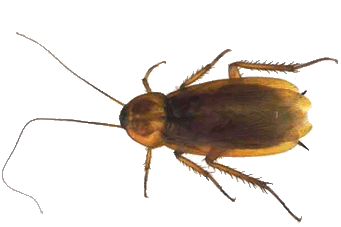 Cockroach Parts
Cockroach Parts

Read about all the bits that make up a cockroach!!!
 Cockroach Parts
Cockroach Parts

EYE: Cockroaches have "compound eyes" which allow them to see simultaneously in almost all directions around its body. Each cockroach eye is made up of 2,000 individual lenses. In contrast, human eyes have only one lens. Weird fact: cockroaches cannot see in red light, but see in green light very well.
LEG: Hairs on the legs of a cockroach provide an extra sense of touch.
ANTENNAE: Sniff, sniff. Antennae, or feelers, provide roaches with a sense of smell. Male cockroaches have special sense receptors that allow them to smell the odour produced by a female when she is looking for a mate.
CERCI: Cerci are the two little hairs on the rear end of a cockroach. They act like a motion detector. When something tries to sneak up on a cockroach, the cerci detects the slightest breeze or movement, and alerts the cockroach to run in the opposite direction. (That must be why it's so hard to swat them!)

MOUTH: A cockroach mouth can smell as well as taste. (Imagine eating with your nose!) It moves from side to side, not up and down the way human mouths do.
SALIVARY GLANDS: Yep, cockroaches know how to, and actually do, spit (thanks to their salivary glands.) They can't blow bubbles, though.
REPRODUCTION: Cockroaches don't date. To attract mates, the female cockroach produces an odour (a pheromone) that excites male cockroaches. Males produce a package of sperm that may keep female cockroaches pregnant for most of their lives. Depending on the species, females can produce egg cases with anywhere from 16 to 64 embryos (young cockroaches).
SKELETON: The skeleton of a cockroach is on the outside of its body. The skeleton is shed when the cockroach outgrows it.
ESOPHAGUS: A cockroach esophagus (a fancy word for throat) isn't as long as a human's, but it gets the job done. Food travels from the mouth, through the esophagus to the stomach.
CROP: The crop is a section at the end of the esophagus used to store food for a while. If a cockroach doesn't chew its food properly, a second set of teeth in its digestive tract, also called a gizzard, gives it another chance.

GASTRIC CAECEA: If cockroaches couldn't digest their food, they'd explode! The gastric caecea are little sacks inside a cockroach that keep germs and enzymes available to help a cockroach digest its food.
MIDGUT: The middle part of the intestine where the cockroach absorbs nutrients is called the midgut.
MALPIGHIAN TUBULES: You say po-tay-toe, I say po-tah-to. You say malpighian tubules, I say cockroach kidney. Either way, it's the same thing! Malpighian tubules clean waste out of the blood. And when they do their job they wiggle like snakes in the "blood" that sloshes around the cockroach's digestive tract.
COLON: Cockroaches not only have a colon, but a rectum, too! Hooray! Special glands in the rectum reabsorb water used during digestion, leaving behind excrement (poop).
HEART: A cockroach has a heart shaped like a tube. Its heart can even stop without the cockroach dying.
SPIRACLES: Cockroaches breath through a bunch of little holes called spiracles in the side of its body. Thin branching tubes carry oxygen from the air to all the parts inside.
FAT BODY: Ever crunch a cockroach? The white gunk that squirts out is the fat body. Like fat in humans, it stores energy. It also breaks down nutrients to provide energy, and helps treat or detoxify insecticides that may be sprayed on the roach (no wonder they're so tough to get rid of).
BRAIN: The cockroach brain is spread throughout its body. The head holds a bit of a nervous system, while the rest of the brain is scattered along the ventral (belly-side) part of its body. So, now you understand that if you cut off the head of a roach, it will still live for as long as one week; eventually dying from starvation or thirst.